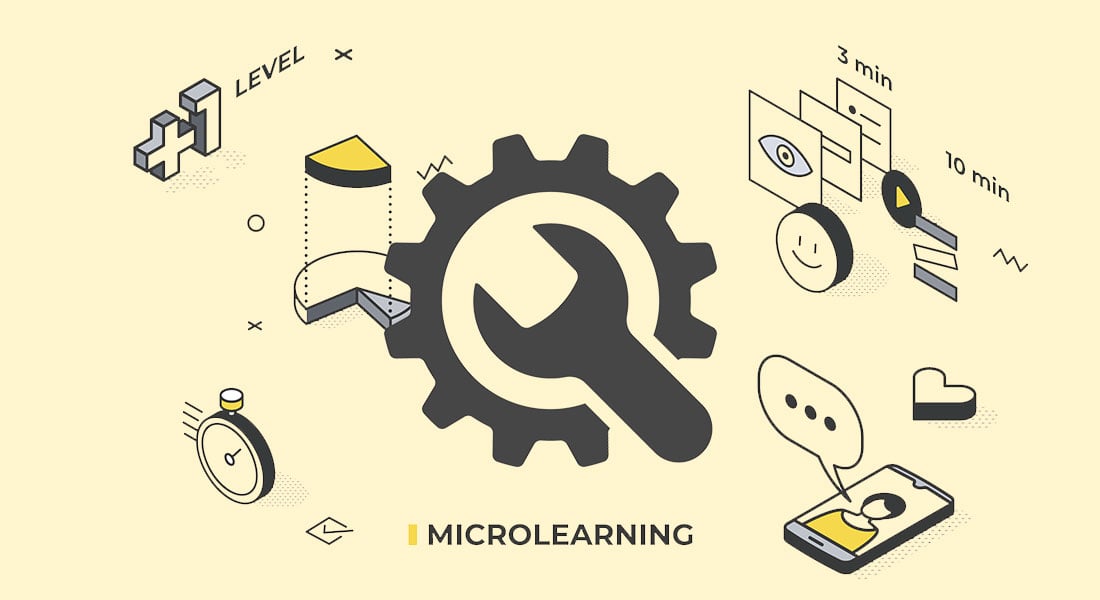Harness Microlearning for Mega Training Benefits

Today’s workforce is performing in a highly competitive environment, and organizations must review and restructure their training strategies periodically to stay in the game, ahead of competition. They must come up with innovative and impactful methods to provide superior knowledge and skills to their workforce.
One such method is microlearning. Today, we will see what this learning method is and how it helps impart corporate training of high quality. We will also see how microlearning can be used in different stages of the learning lifecycle.
What is microlearning?
Microlearning is a learning strategy that delivers information to learners in small chunks. It calls for a long online course to be “broken” into several bite-sized modules, each spanning not more than 3 to 7 minutes and addressing one learning objective comprehensively.
How do microlearning modules help impart good training to workforce?
1. Bite-sized modules are ideal for training learners with short attention spans
Today’s learners have limited attention spans, and this makes it very difficult to impart engaging training using lengthy online courses. Microlearning helps overcome this problem, by satisfying a learning need with very short nuggets of required information. Bite-sized modules are ideal for training time-starved learners and learners on the move. These nuggets can be accessed anytime, anywhere, enabling employees to access information at a convenient time.
2. Learning nuggets are perfectly suited for delivery on mobile devices
Mobile devices are the order of the day, and increasing numbers of people are accessing online content on these devices, and online courses are no exception. The short duration of microlearning modules makes them easily accessible on the small screens of smartphones and tablets.
3. Excellent knowledge support can be provided at the point of need
Microlearning modules are ideal tools to provide effective just-in-time (JIT) learning support to employees, thanks to their short duration and mobile-friendly nature. For instance, a technician of a medical device firm can access the information needed to repair a PET scanner, instantly, on his iPad, in the form of a 3-minute video.
4. Personalized learning can be delivered
Microlearning modules enable companies to provide learning solutions tailored to the needs of individual learners. For instance, a sales rep of an automobile company can opt for a module containing information about competitors’ products, while skipping the modules containing technical information.
How can bite-sized modules be used in different stages of the learning cycle?
Microlearning modules can be used as part of a larger training strategy, in all three phases of the learning cycle viz. pre-training phase, training phase, and the post-training phase.
1. Pre-training phase
Bite-sized online learning modules are ideal for informing learners what they can expect from the training program. This information goes a long way in motivating employees to attend the training program. Consider the following two scenarios.
A large BFSI company releases a 2-minute module containing snippets of an upcoming online compliance training program. The e-learning “trailer” provides a glimpse into the course and how it educates learners about applicable laws in an interesting manner. This convinces learners that the course is not monotonous, thereby motivating them to attend it.
New employees of an automobile manufacturer, who are fresh out of school, are presented a bite-sized video containing a message from the CEO of the company. In his message, the CEO welcomes the recruits and explains how the induction training program helps them integrate seamlessly into the organization. This motivates learners to actively participate in the training program.
You can also use self-paced bite-sized learning modules to see that all learners have the same level of knowledge, when they attend a classroom training session. One of our clients in the drug manufacturing space uses animated video-based microlearning modules to train its sales reps, with no background in life sciences, on concepts of human anatomy and physiology. This helps bridge the knowledge gap between salespeople with different educational backgrounds.
Game-based microlearning modules can be used to evaluate your learners’ existing knowledge levels in an effective manner. One of our clients in the manufacturing sector uses a mini game-based pre-test to evaluate employees’ understanding of Good Manufacturing Practices (GMPs). The results of this pre-test help the client make changes to the training program, to “match” current knowledge levels of the employees.
2. Training phase
Microlearning modules can be used to teach a new skill. You can use video-based learning nuggets very effectively for this purpose. Videos are very useful tools to impart good training and can be used as part of a blended learning strategy. Consider the following scenario.
A medical device company uses a video-based bite-sized online learning module to train its service technicians on the procedure to repair a digital X-ray machine, as part of a blended learning program. The video explains the steps involved in repairing the machine and is delivered on the mobile devices of the learners. The learners, after watching the module, participate in a live workshop to implement the procedure and get hands-on experience on repairing the machine.
3. Post-training phase
Bite-sized modules can be used to evaluate learners’ comprehension of the subject matter, in a very effective manner. One of our clients in the banking sector uses scenario-based learning nuggets to present customer objections to his salespeople, who underwent training, to assess their abilities to hold good customer conversations.
You can also use bite-sized modules to reinforce the learning in classroom and/or online training sessions, by delivering short refresher courses in spaced intervals. Microlearning modules can also be used as ready-reckoners and job-aids, whenever learners are in doubt. Consider the following scenario.
We thus see that bite-sized e-learning modules are very effective in imparting training and can be used in all phases of the learning cycle. Unleash the power of microlearning for training your workforce.



![What are the Best Authoring Tools to Develop Microlearning Assets [Infographic]](https://blog.commlabindia.com/hubfs/blogs/best-authoring-tools-develop-microlearning-assets-info.jpg)

